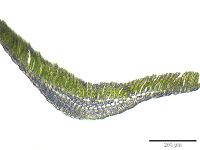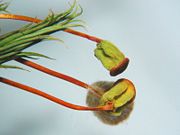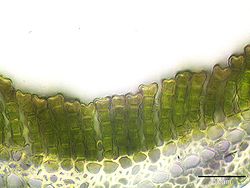
Polytrichum commune
Encyclopedia
Polytrichum commune is a species of moss
found in many regions with high humidity and rainfall. The species can be exceptionally tall for a moss with stems often exceeding 30 cm (12 inches) though rarely reaching 70 cm (28 inches), but it is most commonly found at shorter lengths of 5 to 10 cm (2 to 4 inches). It is widely distributed throughout temperate and boreal latitudes in the Northern Hemisphere and also found in Mexico
, several Pacific Islands including New Zealand
, and also in Australia
. It typically grows in bog
s, wet heathland
and along forest streams.
There are about 15,000 species of moss, but only
four of the easiest-to-grow — fern, hair cap, rock cap and cushion — are commonly sold commercially and suitable for use as ground cover in residential lawns and gardens.(NYTimes 2008 Moss Makes a Lush, No-Care Lawn)
s are present proximally.
The leaves
typically measure 6 to 8 mm in length, but may be up to 12 mm long. When dry they are erect, but when moist they are sinuous with recurved tips and are generally spreading to broadly recurved, or sharply recurved from the base. The leaf sheath is oblong to elliptic in outline, forming an involute (i.e. with inward rolling margins) tube and clasping the stem. This sheath is typically golden yellow and shiny, and it is abruptly contracted to the narrowly lanceolate blade. Using a microscope
, the marginal lamina can be seen to be level or erect, narrow, and typically 2 to 3 cells wide, though sometimes as many as 7 cells wide. It is toothed from the base of the blade up to the apex, with the teeth being unicellular and embedded in the margin. The costa, or central stalk of the leaf, is toothed on the underside near the apex, and is excurrent, meaning it extends beyond the end of the apex, ending in a short, rough awn.
 The lamellae, ridges of cells that run along the leaf surface, are crenulate (i.e. with small rounded teeth) in profile and are 5 to 9 cells high. Their margins are distinctly grooved with 2 rows of paired, projecting knobs. The marginal cells, when observed in section, may be narrow, but are more typically enlarged and wider than those beneath. They are retuse (i.e. with a rounded apex with a central shallow notch) to deeply notched, and in rare cases are divided by a vertical partition. These cells are smooth and brownish in colour and have relatively thick cell walls. The sheath cells measure 60 to 90 µm long by 10 to 13 µm wide. These cells may be elongated rectangles or strongly linear structures up to 20 times long as wide. They become narrower toward the margins. Marginal lamina cells are 10 to 15 µm wide and are subquadrate (i.e. nearly square).
The lamellae, ridges of cells that run along the leaf surface, are crenulate (i.e. with small rounded teeth) in profile and are 5 to 9 cells high. Their margins are distinctly grooved with 2 rows of paired, projecting knobs. The marginal cells, when observed in section, may be narrow, but are more typically enlarged and wider than those beneath. They are retuse (i.e. with a rounded apex with a central shallow notch) to deeply notched, and in rare cases are divided by a vertical partition. These cells are smooth and brownish in colour and have relatively thick cell walls. The sheath cells measure 60 to 90 µm long by 10 to 13 µm wide. These cells may be elongated rectangles or strongly linear structures up to 20 times long as wide. They become narrower toward the margins. Marginal lamina cells are 10 to 15 µm wide and are subquadrate (i.e. nearly square).
 The plants are sexually dioicous. The leaves of the perichaetium have a long sheath with a scarious (i.e. membranous) margin, while the blades themselves are greatly reduced, gradually narrowing to a finely acuminate tip. These blades have toothed margins, are denticulate to subentire in outline, roughened to almost smooth, and have a costa that is excurrent. The seta
The plants are sexually dioicous. The leaves of the perichaetium have a long sheath with a scarious (i.e. membranous) margin, while the blades themselves are greatly reduced, gradually narrowing to a finely acuminate tip. These blades have toothed margins, are denticulate to subentire in outline, roughened to almost smooth, and have a costa that is excurrent. The seta
, or capsule stalk, is 5 to 9 cm long, and is stout and yellowish to reddish brown in colour. The capsule is 3 to 6 mm long, slightly rectangular to cubic in shape, and brown to dark reddish brown in colour. It is sharply 4 winged, inclined to horizontal, and glaucous
when fresh. The peristome
measures 250 µm, is pale in colour and has 64 teeth. The calyptra
is golden yellow to brownish and completely envelops the capsule. The spore
s measure 5 to 8 µm, but may be up to 12 µm.
s, Polytrichum commune shows clear differentiation of water conducting tissue. One of these water conducting tissues is termed the hadrom, which makes up the central cylinder of stem tissue. It consists of cells with a relatively wide diameter called hydroids, which conduct water. This tissue is analogous
to xylem
in higher plants. The other tissue is called leptom, which surround the hadrom and contains smaller cells. This tissue is, on the other hand, analogous to phloem
. When these two tissue types are taken into account along with the species' exceptional height, it becomes clear that common haircap moss is quite a unique moss considering that the majority of species show little differentiation of conducting tissue and are restricted to much smaller stem lengths.
 Another characteristic feature of the species (and the genus) is its parallel photosynthetic
Another characteristic feature of the species (and the genus) is its parallel photosynthetic
lamellae on the upper surfaces of the leaves. Most mosses simply have a single plate of cells on the leaf surface, but common haircap moss has more highly differentiated photosynthetic tissue. This is an example of a xeromorphic adaption, an adaptation for dry conditions. Moist air is trapped in between the rows of lamellae, while the larger terminal cells act to contain moisture and protect the photosynthetic cells. This minimises water loss as relatively little tissue is directly exposed to the environment, but allows for enough gas exchange for photosynthesis to take place. The microenvironment
between the lamellae can host a number of microscopic organisms such as parasitic fungi and rotifer
s. Additionally, the leaves will curve and then twist around the stem when conditions become too dry, this being another xeromorphic adaptation. It is speculated that the teeth along the leaf's edge may aid in this process, or perhaps also that they help discourage small invertebrates from attacking the leaves.
Moss
Mosses are small, soft plants that are typically 1–10 cm tall, though some species are much larger. They commonly grow close together in clumps or mats in damp or shady locations. They do not have flowers or seeds, and their simple leaves cover the thin wiry stems...
found in many regions with high humidity and rainfall. The species can be exceptionally tall for a moss with stems often exceeding 30 cm (12 inches) though rarely reaching 70 cm (28 inches), but it is most commonly found at shorter lengths of 5 to 10 cm (2 to 4 inches). It is widely distributed throughout temperate and boreal latitudes in the Northern Hemisphere and also found in Mexico
Mexico
The United Mexican States , commonly known as Mexico , is a federal constitutional republic in North America. It is bordered on the north by the United States; on the south and west by the Pacific Ocean; on the southeast by Guatemala, Belize, and the Caribbean Sea; and on the east by the Gulf of...
, several Pacific Islands including New Zealand
New Zealand
New Zealand is an island country in the south-western Pacific Ocean comprising two main landmasses and numerous smaller islands. The country is situated some east of Australia across the Tasman Sea, and roughly south of the Pacific island nations of New Caledonia, Fiji, and Tonga...
, and also in Australia
Australia
Australia , officially the Commonwealth of Australia, is a country in the Southern Hemisphere comprising the mainland of the Australian continent, the island of Tasmania, and numerous smaller islands in the Indian and Pacific Oceans. It is the world's sixth-largest country by total area...
. It typically grows in bog
Bog
A bog, quagmire or mire is a wetland that accumulates acidic peat, a deposit of dead plant material—often mosses or, in Arctic climates, lichens....
s, wet heathland
Heath (habitat)
A heath or heathland is a dwarf-shrub habitat found on mainly low quality acidic soils, characterised by open, low growing woody vegetation, often dominated by plants of the Ericaceae. There are some clear differences between heath and moorland...
and along forest streams.
There are about 15,000 species of moss, but only
four of the easiest-to-grow — fern, hair cap, rock cap and cushion — are commonly sold commercially and suitable for use as ground cover in residential lawns and gardens.(NYTimes 2008 Moss Makes a Lush, No-Care Lawn)
Description
Polytrichum commune is a medium to large moss. It is dark green in colour, but becomes brownish with age. The stems can occur in either loose or quite dense tufts, often forming extensive colonies. The stems are most typically found at lengths of 5 to 10 cm, but can be as short as 2 cm or as long as 70 cm. They range in stiffness from erect to decumbent (i.e. reclining) and are usually unbranched, though in rare cases they may be forked. The leaves occur densely to rather distantly, and bractBract
In botany, a bract is a modified or specialized leaf, especially one associated with a reproductive structure such as a flower, inflorescence axis, or cone scale. Bracts are often different from foliage leaves. They may be smaller, larger, or of a different color, shape, or texture...
s are present proximally.
The leaves
Leaf
A leaf is an organ of a vascular plant, as defined in botanical terms, and in particular in plant morphology. Foliage is a mass noun that refers to leaves as a feature of plants....
typically measure 6 to 8 mm in length, but may be up to 12 mm long. When dry they are erect, but when moist they are sinuous with recurved tips and are generally spreading to broadly recurved, or sharply recurved from the base. The leaf sheath is oblong to elliptic in outline, forming an involute (i.e. with inward rolling margins) tube and clasping the stem. This sheath is typically golden yellow and shiny, and it is abruptly contracted to the narrowly lanceolate blade. Using a microscope
Microscope
A microscope is an instrument used to see objects that are too small for the naked eye. The science of investigating small objects using such an instrument is called microscopy...
, the marginal lamina can be seen to be level or erect, narrow, and typically 2 to 3 cells wide, though sometimes as many as 7 cells wide. It is toothed from the base of the blade up to the apex, with the teeth being unicellular and embedded in the margin. The costa, or central stalk of the leaf, is toothed on the underside near the apex, and is excurrent, meaning it extends beyond the end of the apex, ending in a short, rough awn.


Seta
Seta is a biological term derived from the Latin word for "bristle". It refers to a number of different bristle- or hair-like structures on living organisms.-Animal setae:In zoology, most "setae" occur in invertebrates....
, or capsule stalk, is 5 to 9 cm long, and is stout and yellowish to reddish brown in colour. The capsule is 3 to 6 mm long, slightly rectangular to cubic in shape, and brown to dark reddish brown in colour. It is sharply 4 winged, inclined to horizontal, and glaucous
Glaucous
Glaucous is used to describe the pale grey or bluish-green appearance of the surfaces of some plants, as well as in the names of birds, such as the Glaucous Gull , Glaucous-winged Gull , Glaucous Macaw , and Glaucous...
when fresh. The peristome
Peristome
The word peristome is derived from the Greek peri, meaning 'around' or 'about', and stoma, 'mouth'. It is a term used to describe various anatomical features that surround an opening to an organ or structure. The term is used in plants and invertebrate animals, such as in describing the shells of...
measures 250 µm, is pale in colour and has 64 teeth. The calyptra
Calyptra
Calyptra is a scientific term used in botany. It describes a feature in plant morphology.-Bryophytes:In bryophytes, the calyptra is an enlarged archegonial venter that protects the capsule containing the embryonic sporophyte . The calyptra is usually lost before the spores are released from the...
is golden yellow to brownish and completely envelops the capsule. The spore
Spore
In biology, a spore is a reproductive structure that is adapted for dispersal and surviving for extended periods of time in unfavorable conditions. Spores form part of the life cycles of many bacteria, plants, algae, fungi and some protozoa. According to scientist Dr...
s measure 5 to 8 µm, but may be up to 12 µm.
Physiology
Polytrichum commune is an endohydric moss, meaning water must be conducted from the base of the plant. While mosses are considered non-vascular plantNon-vascular plant
Non-vascular plants is a general term for those plants without a vascular system . Although non-vascular plants lack these particular tissues, a number of non-vascular plants possess tissues specialized for internal transport of water....
s, Polytrichum commune shows clear differentiation of water conducting tissue. One of these water conducting tissues is termed the hadrom, which makes up the central cylinder of stem tissue. It consists of cells with a relatively wide diameter called hydroids, which conduct water. This tissue is analogous
Analogy (biology)
An analogy is a trait or an organ that appears similar in two unrelated organisms. The cladistic term for the same phenomenon is homoplasy, from Greek for same form. Biological anologies are often the result of convergent evolution....
to xylem
Xylem
Xylem is one of the two types of transport tissue in vascular plants. . The word xylem is derived from the Classical Greek word ξυλον , meaning "wood"; the best-known xylem tissue is wood, though it is found throughout the plant...
in higher plants. The other tissue is called leptom, which surround the hadrom and contains smaller cells. This tissue is, on the other hand, analogous to phloem
Phloem
In vascular plants, phloem is the living tissue that carries organic nutrients , in particular, glucose, a sugar, to all parts of the plant where needed. In trees, the phloem is the innermost layer of the bark, hence the name, derived from the Greek word "bark"...
. When these two tissue types are taken into account along with the species' exceptional height, it becomes clear that common haircap moss is quite a unique moss considering that the majority of species show little differentiation of conducting tissue and are restricted to much smaller stem lengths.

Photosynthesis
Photosynthesis is a chemical process that converts carbon dioxide into organic compounds, especially sugars, using the energy from sunlight. Photosynthesis occurs in plants, algae, and many species of bacteria, but not in archaea. Photosynthetic organisms are called photoautotrophs, since they can...
lamellae on the upper surfaces of the leaves. Most mosses simply have a single plate of cells on the leaf surface, but common haircap moss has more highly differentiated photosynthetic tissue. This is an example of a xeromorphic adaption, an adaptation for dry conditions. Moist air is trapped in between the rows of lamellae, while the larger terminal cells act to contain moisture and protect the photosynthetic cells. This minimises water loss as relatively little tissue is directly exposed to the environment, but allows for enough gas exchange for photosynthesis to take place. The microenvironment
Microenvironment
Microenvironment carries different meanings depending on the context.* Medical: a small or relatively small usually distinctly specialized and effectively isolated habitat or environment...
between the lamellae can host a number of microscopic organisms such as parasitic fungi and rotifer
Rotifer
The rotifers make up a phylum of microscopic and near-microscopic pseudocoelomate animals. They were first described by Rev. John Harris in 1696, and other forms were described by Anton van Leeuwenhoek in 1703...
s. Additionally, the leaves will curve and then twist around the stem when conditions become too dry, this being another xeromorphic adaptation. It is speculated that the teeth along the leaf's edge may aid in this process, or perhaps also that they help discourage small invertebrates from attacking the leaves.
Variety
- Polytrichum commune var. commune
- Polytrichum commune var. jensenii
- Polytrichum commune var. perigoniale

